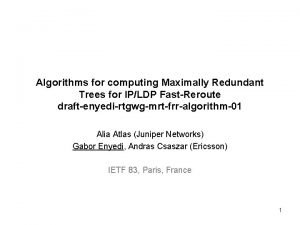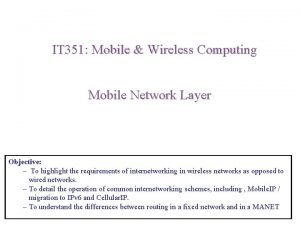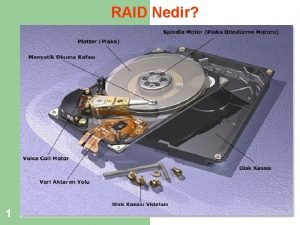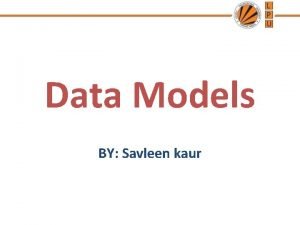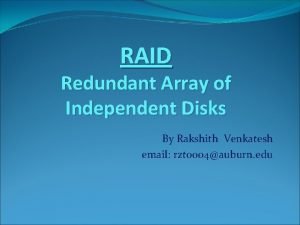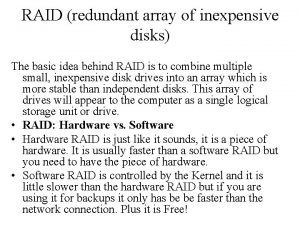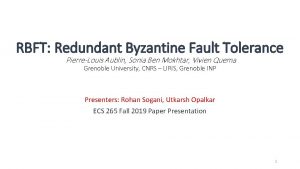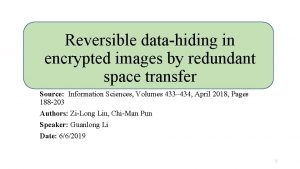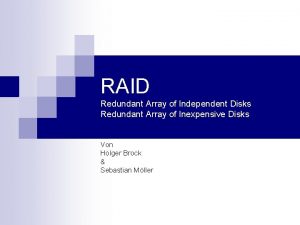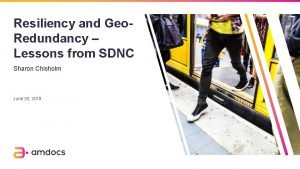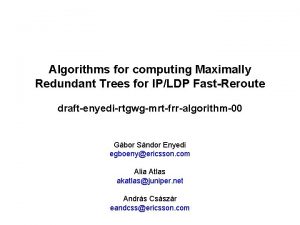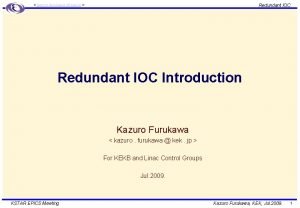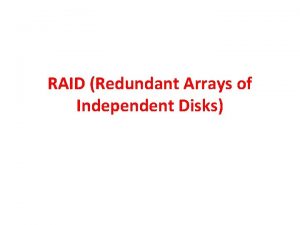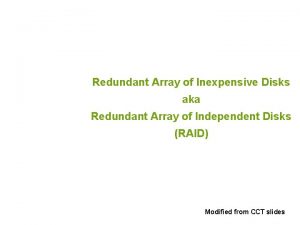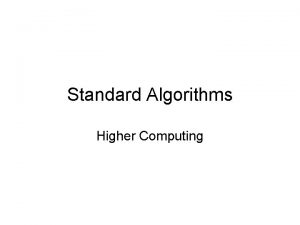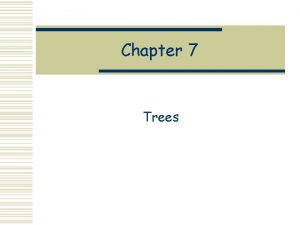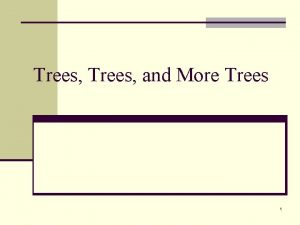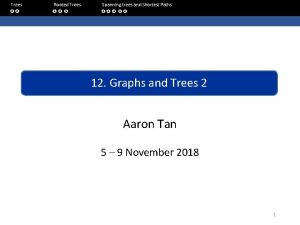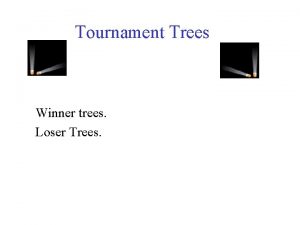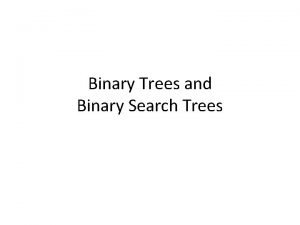Algorithms for computing Maximally Redundant Trees for IPLDP





![ADAG and partial order • S<<E – Blue path: increasing [S, E] – Red ADAG and partial order • S<<E – Blue path: increasing [S, E] – Red](https://slidetodoc.com/presentation_image/c7553e9ffa8b3d6dce1033329ea0454f/image-6.jpg)
![ADAG and partial order • S>>A – Blue path: increasing [S, Root] and [Root, ADAG and partial order • S>>A – Blue path: increasing [S, Root] and [Root,](https://slidetodoc.com/presentation_image/c7553e9ffa8b3d6dce1033329ea0454f/image-7.jpg)













- Slides: 20

Algorithms for computing Maximally Redundant Trees for IP/LDP Fast-Reroute draft-enyedi-rtgwg-mrt-frr-algorithm-01 Alia Atlas (Juniper Networks) Gabor Enyedi, Andras Csaszar (Ericsson) IETF 83, Paris, France 1

Agenda • • Briefly about the algorithm Problem Avoid using a node Non-2 -connected networks 2

Agenda • • Briefly about the algorithm Problem Avoid using a node Non-2 -connected networks 3

ADAG and partial order E G D Root C S B A H 4

ADAG and partial order • Almost DAG (ADAG) • A<<B if there is a path from A to B • Root is both the shortest and the greatest E G D Root C S B A H 5
![ADAG and partial order SE Blue path increasing S E Red ADAG and partial order • S<<E – Blue path: increasing [S, E] – Red](https://slidetodoc.com/presentation_image/c7553e9ffa8b3d6dce1033329ea0454f/image-6.jpg)
ADAG and partial order • S<<E – Blue path: increasing [S, E] – Red path: decreasing [Root, S] and [E, Root] E G D Root C S B A H 6
![ADAG and partial order SA Blue path increasing S Root and Root ADAG and partial order • S>>A – Blue path: increasing [S, Root] and [Root,](https://slidetodoc.com/presentation_image/c7553e9ffa8b3d6dce1033329ea0454f/image-7.jpg)
ADAG and partial order • S>>A – Blue path: increasing [S, Root] and [Root, A] – Red path: decreasing [A, S] E G D Root C S B A H 7

ADAG and partial order • S and C are not ordered – Blue path: [S, E] and [C, E] – Red path: [A, S] and [A, C] E G D Root C S B A H 8

Agenda • • Briefly about the algorithm Problem Avoid using a node Non-2 -connected networks 9

Three trees • We have trees – SPT – Two MRTs • There is no connection between SPT and MRTs • Impossible to find a redundant pair for SPT • Example: Shortest path 1 C D 10 1 S Dest 1 10 No redundant pair for that! 1 B A 1 10

Agenda • • Briefly about the algorithm Problem Avoid using a node Non-2 -connected networks 11

Total order • Partial order can compare any X only with S – We need to compare any two nodes • Make a total order as well – If A<<B, let A<B – If A and B are not ordered select either A<B or B<A – This can be done with a topological oder after converting the ADAG into a DAG • Results: • If A<B, either A<<B or A and B are not ordered 12

A possible total order • Numbers are written next to nodes 8 7 E G D Root 0 6 C 5 S B 1 A 4 3 H 2 13

Possible cases • If dst>>src, failed node F 8 7 E G D Root 0 If S<<F<E, it may be on the BLUE path 6 C 5 S B 1 A 4 3 Otherwise: it may be on the RED path H 2 14

Possible cases • If dst<<src, failed node F Otherwise: it may be on the BLUE path 8 7 E G D Root 0 6 C 5 S 4 3 B it may be If A<F<<S, on the RED path 1 A H 2 15

Possible cases • If dst and src are not ordered – There are four sub-paths If F and src are not 8 ordered, and F>dest, it. E may be on the second part of the RED path Root 0 5 7 G 6 D C F and src are not ordered, and F<dest, it may be on the second part of BLUE path 1 A If F>>src, it may be on the first part of the RED path S 4 3 B H 2 If F<<src, it may be on the first part 16 of the BLUE path

Agenda • • Briefly about the algorithm Problem Avoid using a node Non-2 -connected networks 17

Non-2 -connected problem • In this case we don’t have a single order – Neither a partial order – Nor a total order • Convert the GADAG into an ADAG! C A Non-root block B X Local root block D 18

Non-2 -connected problem • In this case we don’t have a single order – Neither a partial order – Nor a total order • Convert the GADAG into an ADAG! A C X 1 Non-root block B Local root block X 2 D 19

Thank you! 20
 Ipldp
Ipldp Punishment in learning
Punishment in learning Redundant equation example
Redundant equation example Redundant link
Redundant link Raid nedir
Raid nedir Removing redundant attributes in entity sets
Removing redundant attributes in entity sets Redundancy array of independent disk
Redundancy array of independent disk Redundant array of inexpensive disk
Redundant array of inexpensive disk Redundant publications
Redundant publications Redundant byzantine fault tolerance
Redundant byzantine fault tolerance Atbem
Atbem Redundant path topology
Redundant path topology Holger brock
Holger brock Implicant
Implicant Redundant prepuce phimosis and paraphimosis
Redundant prepuce phimosis and paraphimosis Geo
Geo Conventional computing and intelligent computing
Conventional computing and intelligent computing Elektronik för barn
Elektronik för barn Underlag för särskild löneskatt på pensionskostnader
Underlag för särskild löneskatt på pensionskostnader Borra hål för knoppar
Borra hål för knoppar Smärtskolan kunskap för livet
Smärtskolan kunskap för livet
